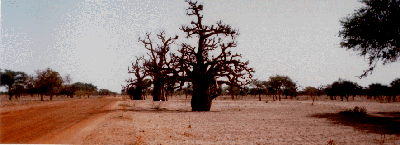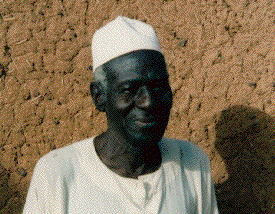

Yet periodically, a giant Baobab tree asserts a silent dominion over this rugged landscape of brush and rock and sand. These grand, grey trees rise from the broad base of an enormous trunk, tapering to a lacework of fine branches high above the Sahel floor. Often singular, occasionally in groups, these unusual trees are always impressive. You know you're in Africa when you see the Baobabs.
The Dogon people say the Baobab trees were punished by an angry god for some long forgotten misdemeanor, and made to grow upside down. In any case, their overly broad base must conceal a network of deep penetrating roots, since water in the Sahel lies far below the baking ground for much of the year, when the rains do not come.
But the trees are not alone here. People have survived and subsisted in this harsh climate for untold centuries. Dogon, Taureg, Mandinka, Puel, Bozo, Songhai and Bambara ethnic groups are in the Sahel, many living far from the rivers, persisting against the odds. I spoke with a missionary who left the green coastal islands of Vancouver to come here in 1960. A nurse, she has seen residents of the Sahel endure wars, droughts, famines, dictatorships and unending disease and malnutrition.
Yet the visitor to this region is greeted with a warmth and generosity that reflects none of the hardship of their existence. What unspoken courage lets these people quietly go on? The tenacity of the Dogon and the Taureg exemplifies the continuity of life on the extreme edge.

They live without electricity, without plumbing, using only a pot of water for bathing. They survive today as they have for centuries. They grow grain and store it in rectangular cisterns, capped with thatched conical rooftops, with storage extending up the cliff and into caves, Pueblo-style.
 Women haul water from deep wells, heaving heavy buckets with ropes and pulleys, then carry the water in urns on their heads. Scarce hardwood is carved into elaborate doorways and ritual masks, bringing a small sense of artistic identity, and relief from the stark, punishing Sahel.
Women haul water from deep wells, heaving heavy buckets with ropes and pulleys, then carry the water in urns on their heads. Scarce hardwood is carved into elaborate doorways and ritual masks, bringing a small sense of artistic identity, and relief from the stark, punishing Sahel.
To the north, the Sahel begins to give way to the desert. Here, in the white heat between sun and Sahara, Taureg nomads, turbaned and robed, continue to ply ancient trading routes on camelback between legendary Timbuktu and the oases of the deep desert. Fiercely individual, occasionally to the point of belligerence, the Tauregs continue to resist integration into other cultures of the region, accepting the hardships of subsistence for the price of independence. Some have edged into Sahel villages, where life is only slightly less harsh; the majority remain on parts of the map that show no roads, no water, no connection at all to the world we know.
An ancient race of former slaves, the Bela, remain close to the Taureg who once owned them, sharing their poverty and working only for food, to this day. I saw a single Bela woman in a village marketplace, wearing the heavy brass ankle bracelets that recall her people's bondage.
The Sahel where the Dogon and Taureg live is mostly in Mali, which is the size of Texas and California combined, but among the five poorest nations on earth. Illiteracy predominates, blunting initiative and innovation, and perpetuating the crushing cycles of poverty. Children, who in the Western world would be at school, have already begun working to help provide some of their own support to their impoverished families. Yet, these people do not despair. And from their towering perspectives, the Baobab trees may be witnessing a new chapter in the lives of their neighbors.
Democracy has replaced dictatorship, and in the ensuing calm the Sahel is receiving an influx of aid workers, who with the missionaries and other volunteers are making a difference. Disease and malnutrition, though still prevalent, are in decline.
Solar powered wells are starting to appear, and droughts which devastated this region for decades have subsided. Reforestation programs are beginning, gradually, to halt the encroaching Sahara. Small crop surpluses are permitting tiny export businesses to emerge. Dogon art, in its primal innocence, is gaining recognition and value internationally. A small tourism industry is inviting a trickle of foreign currency into the region.
Slowly, slowly, hope is starting to glow like an ember in a Dogon campfire, in a region once counted as beyond hope. Like the great trees among them, the people of the Sahel are, imperceptibly, growing. The depth of character borne of the courage of the centuries continues to sustain life.
He wrote this story exclusively for The New Sun
following a recent trip through the Sahel in Mali.
 Home |